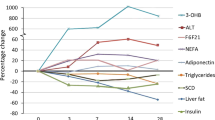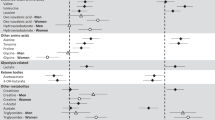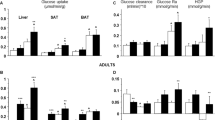Abstract
Objective:
Non-alcoholic fatty liver disease (NAFLD) is associated with abnormalities in basal glucose and free fatty acid (FFA) metabolism, multi-organ insulin resistance and alterations in lipoprotein kinetics. These metabolic outcomes can be evaluated in vivo by using stable isotopically labeled tracer methods. An understanding of the reproducibility of these measures is necessary to ensure adequate statistical power in studies designed to evaluate metabolic function in subjects with NAFLD.
Methods:
We determined the degree of intra-individual variability of skeletal muscle, adipose tissue, and hepatic insulin sensitivity and basal plasma glucose, FFA, and very-low-density lipoprotein triglyceride and apolipoprotein B-100 (apoB-100) kinetics in eight obese subjects with NAFLD (age: 44±3 years; body mass index: 38.2±1.7 kg m−2; intrahepatic triglyceride content: 24.5±3.9%), by using the hyperinsulinemic-euglycemic clamp technique and stable isotope-labeled tracer methods and mathematical modeling on two separate occasions ∼2 months apart.
Results:
The intra-individual variability (coefficient of variation) ranged from 6% for basal glucose production to 21% for insulin-stimulated glucose disposal (percentage increase from basal). We estimated that a 25% difference in any outcome measure can be detected with a sample size of ⩽8 subjects for paired studies and ⩽15 subjects per group for unpaired studies, assuming an α value of 0.05 and a β value of 0.20 (that is, 80% power).
Conclusion:
These results demonstrate that only a small number of subjects are needed to detect clinically relevant effects in insulin sensitivity and hepatic lipoprotein metabolism in obese subjects with NAFLD, and will be useful to determine appropriate sample size for future metabolic studies.
This is a preview of subscription content, access via your institution
Access options
Subscribe to this journal
Receive 12 print issues and online access
$259.00 per year
only $21.58 per issue
Buy this article
- Purchase on Springer Link
- Instant access to full article PDF
Prices may be subject to local taxes which are calculated during checkout

Similar content being viewed by others
References
Angulo P . Nonalcoholic fatty liver disease. N Engl J Med 2002; 346: 1221–1231.
Kleiner DE, Brunt EM, Van Natta M, Behling C, Contos MJ, Cummings OW et al. Design and validation of a histological scoring system for nonalcoholic fatty liver disease. Hepatology 2005; 41: 1313–1321.
Marchesini G, Brizi M, Bianchi G, Tomassetti S, Bugianesi E, Lenzi M et al. Nonalcoholic fatty liver disease: a feature of the metabolic syndrome. Diabetes 2001; 50: 1844–1850.
Fabbrini E, Magkos F, Mohammed BS, Pietka T, Abumrad NA, Patterson BW et al. Intrahepatic fat, not visceral fat, is linked with metabolic complications of obesity. Proc Natl Acad Sci USA 2009; 106: 15430–15435.
Targher G, Arcaro G . Non-alcoholic fatty liver disease and increased risk of cardiovascular disease. Atherosclerosis 2007; 191: 235–240.
Korenblat KM, Fabbrini E, Mohammed BS, Klein S . Liver, muscle, and adipose tissue insulin action is directly related to intrahepatic triglyceride content in obese subjects. Gastroenterology 2008; 134: 1369–1375.
Magkos F, Mittendorfer B . Stable isotope-labeled tracers for the investigation of fatty acid and triglyceride metabolism in humans in vivo. Clin Lipidol 2009; 4: 215–230.
Burnett JR, Barrett PH . Apolipoprotein B metabolism: tracer kinetics, models, and metabolic studies. Crit Rev Clin Lab Sci 2002; 39: 89–137.
Kotronen A, Seppala-Lindroos A, Bergholm R, Yki-Jarvinen H . Tissue specificity of insulin resistance in humans: fat in the liver rather than muscle is associated with features of the metabolic syndrome. Diabetologia 2008; 51: 130–138.
Fabbrini E, Mohammed BS, Magkos F, Korenblat KM, Patterson BW, Klein S . Alterations in adipose tissue and hepatic lipid kinetics in obese men and women with nonalcoholic fatty liver disease. Gastroenterology 2008; 134: 424–431.
Fabbrini E, deHaseth D, Deivanayagam S, Mohammed BS, Vitola BE, Klein S . Alterations in fatty acid kinetics in obese adolescents with increased intrahepatic triglyceride content. Obesity (Silver Spring) 2009; 17: 25–29.
Kirk E, Reeds DN, Finck BN, Mayurranjan SM, Patterson BW, Klein S . Dietary fat and carbohydrates differentially alter insulin sensitivity during caloric restriction. Gastroenterology 2009; 136: 1552–1560.
Vitola BE, Deivanayagam S, Stein RI, Mohammed BS, Magkos F, Kirk EP et al. Weight loss reduces liver fat and improves hepatic and skeletal muscle insulin sensitivity in obese adolescents. Obesity (Silver Spring) 2009; 17: 1744–1748.
Fabbrini E, Mohammed BS, Korenblat KM, Magkos F, McCrea J, Patterson BW et al. Effect of fenofibrate and niacin on intrahepatic triglyceride content, very low-density lipoprotein kinetics, and insulin action in obese subjects with nonalcoholic fatty liver disease. J Clin Endocrinol Metab 2010; 95: 2727–2735.
Ricos C, Alvarez V, Cava F, Garcia-Lario JV, Hernandez A, Jimenez CV et al. Current databases on biological variation: pros, cons and progress. Scand J Clin Lab Invest 1999; 59: 491–500.
Lazo M, Selvin E, Clark JM . Brief communication: clinical implications of short-term variability in liver function test results. Ann Intern Med 2008; 148: 348–352.
Frimel TN, Deivanayagam S, Bashir A, O'Connor R, Klein S . Assessment of intrahepatic triglyceride content using magnetic resonance spectroscopy. J Cardiometab Syndr 2007; 2: 136–138.
Magkos F, Patterson BW, Mittendorfer B . Reproducibility of stable isotope-labeled tracer measures of VLDL-triglyceride and VLDL-apolipoprotein B-100 kinetics. J Lipid Res 2007; 48: 1204–1211.
Mittendorfer B, Patterson BW, Klein S . Effect of weight loss on VLDL-triglyceride and apoB-100 kinetics in women with abdominal obesity. Am J Physiol Endocrinol Metab 2003; 284: E549–E556.
Patterson BW, Zhao G, Elias N, Hachey DL, Klein S . Validation of a new procedure to determine plasma fatty acid concentration and isotopic enrichment. J Lipid Res 1999; 40: 2118–2124.
Klein S, Mittendorfer B, Eagon JC, Patterson B, Grant L, Feirt N et al. Gastric bypass surgery improves metabolic and hepatic abnormalities associated with nonalcoholic fatty liver disease. Gastroenterology 2006; 130: 1564–1572.
Patterson BW, Mittendorfer B, Elias N, Satyanarayana R, Klein S . Use of stable isotopically labeled tracers to measure very low density lipoprotein-triglyceride turnover. J Lipid Res 2002; 43: 223–233.
Mittendorfer B, Patterson BW, Klein S . Effect of sex and obesity on basal VLDL-triacylglycerol kinetics. Am J Clin Nutr 2003; 77: 573–579.
Magkos F, Wright DC, Patterson BW, Mohammed BS, Mittendorfer B . Lipid metabolism response to a single, prolonged bout of endurance exercise in healthy young men. Am J Physiol Endocrinol Metab 2006; 290: E355–E362.
Lewis GF . Fatty acid regulation of very low density lipoprotein production. Curr Opin Lipidol 1997; 8: 146–153.
Elovson J, Chatterton JE, Bell GT, Schumaker VN, Reuben MA, Puppione DL et al. Plasma very low density lipoproteins contain a single molecule of apolipoprotein B. J Lipid Res 1988; 29: 1461–1473.
Hopkins WG . Measures of reliability in sports medicine and science. Sports Med 2000; 30: 1–15.
Magkos F, Wang X, Mittendorfer B . Metabolic actions of insulin in men and women. Nutrition 2010; 26: 686–693.
DeFronzo RA, Tobin JD, Andres R . Glucose clamp technique: a method for quantifying insulin secretion and resistance. Am J Physiol 1979; 237: E214–E223.
Fossum E, Hoieggen A, Moan A, Nordby G, Kjeldsen SE . Insulin sensitivity relates to other cardiovascular risk factors in young men: validation of some modifications of the hyperinsulinaemic, isoglycaemic glucose clamp technique. Blood Press Suppl 1997; 2: 113–119.
Mather KJ, Hunt AE, Steinberg HO, Paradisi G, Hook G, Katz A et al. Repeatability characteristics of simple indices of insulin resistance: implications for research applications. J Clin Endocrinol Metab 2001; 86: 5457–5464.
Soop M, Nygren J, Brismar K, Thorell A, Ljungqvist O . The hyperinsulinaemic-euglycaemic glucose clamp: reproducibility and metabolic effects of prolonged insulin infusion in healthy subjects. Clin Sci (Lond) 2000; 98: 367–374.
Becker RH, Frick AD, Teichert L, Nosek L, Heinemann L, Heise T et al. Fluctuation and reproducibility of exposure and effect of insulin glargine in healthy subjects. Diabetes Obes Metab 2008; 10: 1105–1113.
Morris AD, Ueda S, Petrie JR, Connell JM, Elliott HL, Donnelly R . The euglycaemic hyperinsulinaemic clamp: an evaluation of current methodology. Clin Exp Pharmacol Physiol 1997; 24: 513–518.
Bokemark L, Froden A, Attvall S, Wikstrand J, Fagerberg B . The euglycemic hyperinsulinemic clamp examination: variability and reproducibility. Scand J Clin Lab Invest 2000; 60: 27–36.
Hedman A, Berglund L, Essen-Gustavsson B, Reneland R, Lithell H . Relationships between muscle morphology and insulin sensitivity are improved after adjustment for intra-individual variability in 70-year-old men. Acta Physiol Scand 2000; 169: 125–132.
Li W, Tonelli J, Kishore P, Owen R, Goodman E, Scherer PE et al. Insulin-sensitizing effects of thiazolidinediones are not linked to adiponectin receptor expression in human fat or muscle. Am J Physiol Endocrinol Metab 2007; 292: E1301–E1307.
Ross R, Dagnone D, Jones PJ, Smith H, Paddags A, Hudson R et al. Reduction in obesity and related comorbid conditions after diet-induced weight loss or exercise-induced weight loss in men. A randomized, controlled trial. Ann Intern Med 2000; 133: 92–103.
Schrauwen-Hinderling VB, Mensink M, Hesselink MK, Sels JP, Kooi ME, Schrauwen P . The insulin-sensitizing effect of rosiglitazone in type 2 diabetes mellitus patients does not require improved in vivo muscle mitochondrial function. J Clin Endocrinol Metab 2008; 93: 2917–2921.
Haus JM, Solomon TP, Marchetti CM, Edmison JM, Gonzalez F, Kirwan JP . Free fatty acid-induced hepatic insulin resistance is attenuated following lifestyle intervention in obese individuals with impaired glucose tolerance. J Clin Endocrinol Metab 2010; 95: 323–327.
Juurinen L, Kotronen A, Graner M, Yki-Jarvinen H . Rosiglitazone reduces liver fat and insulin requirements and improves hepatic insulin sensitivity and glycemic control in patients with type 2 diabetes requiring high insulin doses. J Clin Endocrinol Metab 2008; 93: 118–124.
Racette SB, Davis AO, McGill JB, Klein S . Thiazolidinediones enhance insulin-mediated suppression of fatty acid flux in type 2 diabetes mellitus. Metabolism 2002; 51: 169–174.
Shadid S, Jensen MD . Pioglitazone increases non-esterified fatty acid clearance in upper body obesity. Diabetologia 2006; 49: 149–157.
Magkos F, Patterson BW, Mittendorfer B . No effect of menstrual cycle phase on basal very-low-density lipoprotein triglyceride and apolipoprotein B-100 kinetics. Am J Physiol Endocrinol Metab 2006; 291: E1243–E1249.
Walsh BW, Schiff I, Rosner B, Greenberg L, Ravnikar V, Sacks FM . Effects of postmenopausal estrogen replacement on the concentrations and metabolism of plasma lipoproteins. N Engl J Med 1991; 325: 1196–1204.
Adiels M, Taskinen MR, Packard C, Caslake MJ, Soro-Paavonen A, Westerbacka J et al. Overproduction of large VLDL particles is driven by increased liver fat content in man. Diabetologia 2006; 49: 755–765.
Bilz S, Wagner S, Schmitz M, Bedynek A, Keller U, Demant T . Effects of atorvastatin versus fenofibrate on apoB-100 and apoA-I kinetics in mixed hyperlipidemia. J Lipid Res 2004; 45: 174–185.
Watts GF, Barrett PH, Ji J, Serone AP, Chan DC, Croft KD et al. Differential regulation of lipoprotein kinetics by atorvastatin and fenofibrate in subjects with the metabolic syndrome. Diabetes 2003; 52: 803–811.
Ginsberg HN, Le NA, Gibson JC . Regulation of the production and catabolism of plasma low density lipoproteins in hypertriglyceridemic subjects. Effect of weight loss. J Clin Invest 1985; 75: 614–623.
Acknowledgements
This study was supported by National Institutes of Health grants DK 37948, DK 56341 (Nutrition Obesity Research Center), RR024992 (Clinical and Translational Science Award) and RR-00954 (Biomedical Mass Spectrometry Resource). The authors thank Freida Custodio and Jennifer Shew for technical assistance, the staff of the Clinical Research Unit for their help in performing the studies and the study subjects for their participation.
Author information
Authors and Affiliations
Corresponding author
Ethics declarations
Competing interests
The authors declare no conflict of interest.
Rights and permissions
About this article
Cite this article
Magkos, F., Fabbrini, E., Korenblat, K. et al. Reproducibility of glucose, fatty acid and VLDL kinetics and multi-organ insulin sensitivity in obese subjects with non-alcoholic fatty liver disease. Int J Obes 35, 1233–1240 (2011). https://doi.org/10.1038/ijo.2010.265
Received:
Revised:
Accepted:
Published:
Issue Date:
DOI: https://doi.org/10.1038/ijo.2010.265



